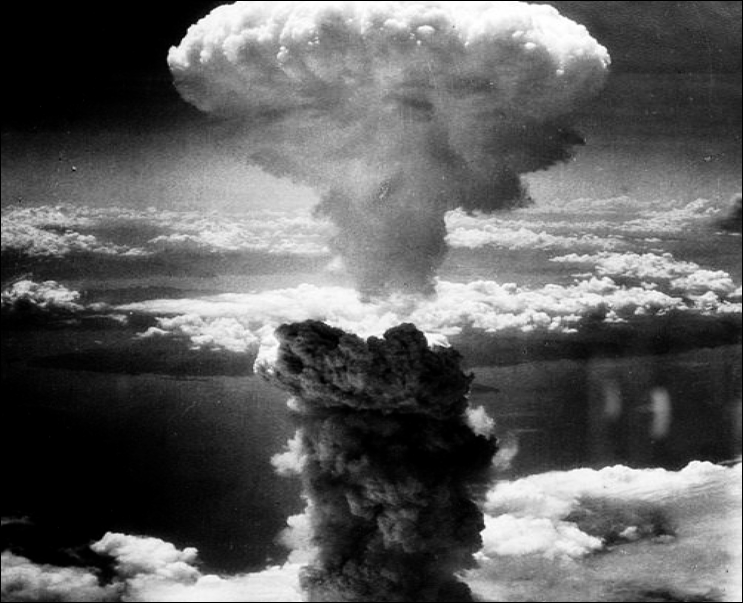Winner of the Spring 2017 StMU History Media Awards for
Best Article in the Category of “World History”
“We knew the world would not be the same. A few people laughed, a few people cried, most people were silent. I remembered the line from the Hindu scripture the Bhagavad Gita. Vishnu is trying to persuade the prince that he should do his duty and to impress him takes on his multiarmed form and says, ‘Now, I am become Death, the destroyer of worlds.’ I suppose we all thought that one way or another.”1
- J. Robert Oppenheimer, The Decision to Drop the Bomb

Throughout the history of human warfare, conflict has pushed humans to innovate–to build ever larger and deadlier weapons, each more lethal than the last. However, it was not until World War II and the invention of the atomic bomb that humanity has been able to kill on such a massive and efficient scale. Case in point, in the final days of World War II, the United States carried out one of the most chilling instances of mass murder in the history of humanity: the bombing of the Japanese cities of Hiroshima and Nagasaki. These attacks ultimately killed an estimated 294,000 people, the majority of whom were noncombatants.2 In comparison, the Japanese attack on Pearl Harbor killed just 2,408 American citizens, although this is largely due to the focused Japanese attack on military targets, namely the Pacific fleet and U.S. airfields.3 To give a more modern frame of comparison, the terrorist attacks against the World Trade Center and Pentagon, considered to be by far the worst terrorist attacks against the United States, claimed the lives of 2,974 American citizens.4
In the spring of 1945, World War II was entering its final stages. The Allies had already achieved victory in Europe with Germany’s surrender on May 7th, but the conflict on the Pacific front was still going strong. In the years leading up to the two World Wars, Japan’s victories against two larger countries–China in the Sino-Japanese War (1894–1895) and Russia in the Russo-Japanese War (1904–1905)–combined with other factors, forged a strong sense of Japanese nationalism, militarism, and cultural superiority. This fervent nationalism, integrated with the Japanese warrior ethic known as bushido, made the prospect of a Japanese surrender unlikely, even as the Allies began to position for an invasion of the Japanese mainland.5

Concurrently, since as early as 1942, President Franklin Delano Roosevelt had been secretly sponsoring and funding The Manhattan Project, the code name used for the $2 billion U.S. effort to develop a nuclear weapon before the Germans. A team of top physicists led by Dr. Julius Robert Oppenheimer were assigned to this project, a task so secret that not even individuals as important as then Vice President Harry S. Truman was aware of it. Shortly after Roosevelt’s untimely death and Truman’s subsequent inauguration to the presidency in April 1945, he was informed that the Manhattan Project was approaching success–that a nuclear weapon would be feasible in just four short months.6
Faced with the prospect of a costly and deadly invasion of Japan, Truman and his advisors were faced with a difficult choice: utilize this new atomic weapon or try to defeat Japan through conventional means. In late July, the United States issued the Postdam Declaration, a statement which gave Japan the choice between unconditional surrender or total annihilation. When this declaration went ignored, President Truman authorized the use of the atomic bomb.7

On the morning of August 6, 1945, Colonel Paul Tibbets piloted the Enola Gay over the city of Hiroshima, where his crew dropped an atomic bomb code-named “Little Boy.” Upwards of 70,000 people died instantly in the blast. Additionally, 48,000 buildings were destroyed and another 22,000 were damaged, leaving only 6,000 buildings untouched. Three days later, on August 9th, a second bomb was dropped onto Nagasaki, killing another 36,000 people. In total, an estimated 295,000 were killed in the blasts or from complications from the resulting nuclear fallout.8
Emperor Hirohito ordered the surrender of Japan on August 10, 1945. On August 15th, radios across Japan broadcasted Hirohito’s words as he read the declaration of surrender to the Japanese people, thus ending World War II. The bombs’ effectiveness in forcing the Japanese to surrender is still subject of popular debate among historians to this day, given that the Russian invasion of Japan-controlled Manchuria occurred at the same time of Nagasaki, both of which likely impacted Japan’s will to continue fighting.9 Even so, while the political and military effects of these blasts may be debated, none can contest their tragedy and devastation.

- Jason Pontin, “Oppenheimer’s Ghost,” MIT Technology Review, October 15, 2007. https://www.technologyreview.com/s/408835/oppenheimers-ghost/. ↵
- Dennis W. Cheek, “Hiroshima and Nagasaki,” in Encyclopedia of Science, Technology, and Ethics, edited by Carl Mitcham, Vol. 2, Detroit: Macmillan Reference USA, 2005. Gale Virtual Reference Library (accessed February 6, 2017), 923. ↵
- Sonia Benson, Daniel E. Brannen, Jr., and Rebecca Valentine, “Pearl Harbor Attack,” in UXL Encyclopedia of U.S. History, Vol. 6, Detroit: UXL, 2009. Gale Virtual Reference Library (accessed February 6, 2017), 1208. ↵
- Stefan M. Brooks, “September 11 Attacks,” in The Encyclopedia of Middle East Wars: The United States in the Persian Gulf, Afghanistan, and Iraq Conflicts, edited by Spencer C. Tucker, Vol. 3, Santa Barbara, CA: ABC-CLIO, 2010. Gale Virtual Reference Library (accessed February 6, 2017), 1096. ↵
- “The United States Drops the Atomic Bomb on Hiroshima and Nagasaki,” in Global Events: Milestone Events Throughout History, edited by Jennifer Stock, Vol. 2, Asia and Oceania, Farmington Hills, MI: Gale, 2014. Gale Virtual Reference Library (accessed February 5, 2017), 361. ↵
- “An Overview of the Atomic Bombings of Hiroshima and Nagasaki,” in The Atomic Bombings of Hiroshima and Nagasaki, edited by Sylvia Engdahl, Perspectives on Modern World History, Detroit: Greenhaven Press, 2011. Gale Virtual Reference Library (accessed February 6, 2017), 13-14. ↵
- “An Overview of the Atomic Bombings of Hiroshima and Nagasaki,” in The Atomic Bombings of Hiroshima and Nagasaki, edited by Sylvia Engdahl, Perspectives on Modern World History, Detroit: Greenhaven Press, 2011. Gale Virtual Reference Library (accessed February 6, 2017), 14-15. ↵
- Dennis W. Cheek, “Hiroshima and Nagasaki,” in Encyclopedia of Science, Technology, and Ethics, edited by Carl Mitcham, Vol. 2, Detroit: Macmillan Reference USA, 2005. Gale Virtual Reference Library (accessed February 6, 2017), 923. ↵
- “The United States Drops the Atomic Bomb on Hiroshima and Nagasaki,” in Global Events: Milestone Events Throughout History, edited by Jennifer Stock, Vol. 2, Asia and Oceania, Farmington Hills, MI: Gale, 2014. Gale Virtual Reference Library (accessed February 5, 2017), 361. ↵



152 comments
Briana Bustamante
Such a great article! It was such an informative article and I enjoyed reading it. I remember learning about this when I was younger. I did not remember the detail about the bombings, only the numerous lives that were lost. The facts and quotes that you used to back up your claim were good. The quote that you used in the beginning of your article really set the tone for your article. Great work!
Samuel Sanchez
I did not know that Truman was unaware of the Manhattan Project. I guess Roosevelt wanted to keep that secret which is understandable since it is such a dangerous weapon. After the death of Roosevelt. Truman faced a tough decisions if he should utilize the weapon. He obviously made the right one since if not maybe the Japanese would have did more damage. Interesting article, very informative.
Priscilla Reyes
Wow! I thought it was interesting that President Truman had no idea of the Manhattan Project. And in my opinion, the bomb was not a way to end war. However, because the nuclear bomb was developed and ready, it was an option. It was a fast way to end war, but unfair to the people of Hiroshima and Nagasaki. Although we learn about these events in school, the U.S. will never place emphasis on it. Still, the tragedy will never be forgotten. Great article, Cameron! Thank you for adding the comparison between lives lost during the war, and during the different bombings, they were impactful!
Aimee Trevino
Really interesting article! I of course had heard of the use of the atomic bomb to end WWII, but I like how you included numbers, and compared the number of people killed by the atomic bomb to the number of people killed during the terrorist attacks of 9/11. That really put it in perspective, and it is honestly so sad to see that that many people had to lose their lives. Overall, really well written, and I look forward to reading more of your work.
Victoria Sanchez
I appreciate the focus on tragedy that you include in your article. I think that most accounts of these bombings focus on the victory of the U.S., on the successful bomb construction that was done by American citizens, and on some false sense of pride resulting from Japan’s surrender. Your article, while still acknowledging that the bomb was in some respects a success, did a wonderful job of exploring other aspects of the bombings, namely the innocent lives that were lost. The comparisons you gave were mind-blowing, and the numbers really caused me to put the Hiroshima-Nagasaki bombings into context. My grandfather–who was in a Navy ship off the coast of both Hiroshima and Nagasaki when the bombs were dropped–was proud of the U.S. victory, yet I can remember him admitting the sheer magnitude and effect of civilians from the bombings. I think it is important to look to the truth behind these past events when considering current situations, and your article provides a great way to do that. Awesome job!
Lianna Ybarra
First off, awesome job on this article. From the second I started reading the quote from the person who decided to drop the bomb I was intrigued. I first learned about the bombings when I was in middle school and always thought how it was terrible how we had to kill innocent people but that was the only way they would surrender. I didn’t know though that this is one of the highest killing civilian attacks on a country.
Elizabeth Garibay
This article was very interesting! I honestly never knew about the nuclear bombing of Nagasaki and Hiroshima and that it was a turning point in Human history. I really enjoyed the quotes in the pictures, it made me feel as if the picture had a story to tell. As I continued to read more and more I felt such sympathy for the American soldiers and their families.Although Truman had an obligation this was still the greatest tragedy that Japan had ever faced which I’m sure left many scars and battle whoms .
Cesar Zavala
Good fact on the first uses of the atomic bomb by the United States. The bombing of Hiroshima and Nagasaki is a very controversial topic in United States government. On the pro side, the atomic bomb let the United States show their power to the Japanese forcing them to surrender, ultimately saving lives had they gone to war. But on the con side, dropping the bombs in major civilian cities was uncalled for and unethical by our government. Good article and great facts.
Nahim Rancharan
This article was very interesting to read given that I knew little about the bombings of Hiroshima and Nagasaki in Japan. It is interesting to see how although President FDR was unable to test the project that he so heavily invested in, President Truman, his successor, was still able to follow through with FDR’s motives of “speak softly and carry a big stick.” Effectively, this article shows how the U.S, in many times in the past was concerned with always maintaining a level of control in terms of diplomatic relations, even if it means showing the U.S’s strength in terms of military power when necessary. These bombings were just some of the few in which the U.S has shown their power. Unfortunately, these incidents have resulted in the loss of several thousand innocent lives and it is important not to forget these incidents from the past, especially since we are now in a Nuclear Age. Good Article!
Steven Clinton
The nuclear bombing of Hiroshima was relatively revolutionary. The aftermath of the bombing ended the war, but a single bomb killed a hundred thousands of people. Japan suffered the consequences for many years. I really liked your article, I found it quite interesting. The nuclear disaster cause quite a controversy and it forever changed the rules to war. What an amazing article.